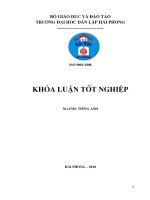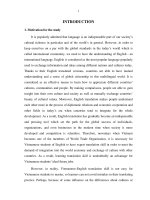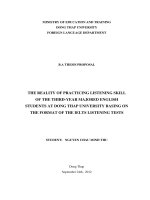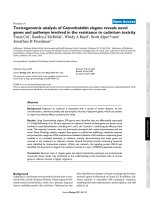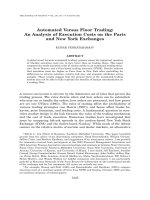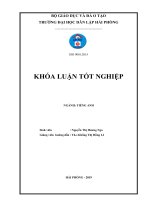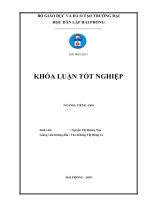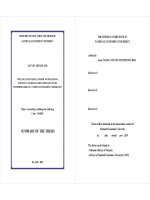The study: An analysis of common errors on verb tenses and word choices in VietnameseEnglish translation by the secondyear English majors at Dong Thap University
Bạn đang xem bản rút gọn của tài liệu. Xem và tải ngay bản đầy đủ của tài liệu tại đây (595.09 KB, 81 trang )
1
INTRODUCTION
1. Motivation for the study
It is popularly admitted that language is an indispensable part of our society‟s
cultural richness in particular and of the world‟s in general. However, in order to
keep ourselves on a par with the global standards in the today‟s world which is
called international community, we need to have the understanding of English - an
international language. English is considered as the most popular language popularly
used to exchange information and ideas among different nations and cultures today.
Thanks to their English translated versions, countries are able to have mutual
understanding and a sense of global citizenship in this multilingual world. It is
considered as an effective means to learn how to appreciate different countries‟
cultures, communities and people. By making comparisons, people are able to gain
insight into their own culture and society as well as mutually exchange countries‟
beauty of cultural values. Moreover, English translation makes people understand
each other more in the process of diplomatic relations and economic cooperation and
other fields in today‟s era when countries tend to integrate for the whole
development. As a result, English translation has gradually become an indispensable
and pressing tool which set the path for the global success of individuals,
organizations, and even businesses in the modern time when society is more
developed and competition is relentless. Therefore, nowadays when Vietnam
becomes one of the members of World Trade Organization, it is necessary for
Vietnamese students of English to have expert translation skill in order to meet the
demand of integration into the world economy and exchange of culture with other
countries. As a result, learning translation skill is undoubtedly an advantage for
Vietnamese students‟ ideal future jobs.
However, in reality, Vietnamese-English translation skill is not easy for
Vietnamese students to master, so learners can not avoid mistakes in their translating
prsctice. Perhaps, because of some influence on the differences about cultures or
2
their own limited language ability, etc, Vietnamese students of English in general
still have mistakes on grammar, word choices and so on in translating Vietnamese
texts into English. The study Common mistakes in learning translation subject by
the second-year English majors at Dong Thap University (Duong Thi Thuy Hang
and Nguyen Thi Cam Xuyen, 2010, p.32-p.33) found the followings:
Lack of vocabulary causes many problems in translation process, frequently; they
could not choose the right word in the context and tried or code it did not know.
In the final text for BA English 2006 class, in the part of Vietnamese-to-English
translation, there was a phrase: “Đơn xin thị thực”- and the large percentage of
the students could not understand the meaning of the phrase. Therefore, they
translated with a wrong meaning or skipped it. Many students did not know what
“thị thực” means, and they thought that it was a thing related to food, so in many
test papers, it is translated into “food” as in the following: “Đơn xin thị thực”
The answer is “Visa Application Form”. The translated phrases by the students:
“Declaration going food”
“Enter-exit food”
“Form of beg for food”
“Giving foods form”…
The mistakes in tenses as in:
“Con bé dường như buồn ngủ” (this sentence was extracted from the first
semester final test papers for BA English 2007 class).
The key is “The little girl seems sleepy”. But many students translated into: “The
little girl is seem sleepy”, they were confused with the verb “to be” and the verb
“seem”.
In these situations, foreigners will misunderstand, even be not able to
understand the meaning of the passage when they read.
3
Located on Mekong Delta which is considered as the agriculture and
aquaculture area, a special place in the strategy of economic and social development,
and national security of the country, Dong Thap University has experienced nine
years of establishment and development. It has had great achievements in training
human resources for the Mekong Delta and the country. According to PhD. Nguyen
Van De, Rector of Dong Thap University, one of the main tasks of the school is
training and fostering teachers with professional skills at all educational levels and
highly qualified personnel in other areas in order to contribute to the development of
the Mekong Delta and the country (Đại học Đồng Tháp: Hướng tới “Chất lượng -
Hiệu quả - Uy tín - Chuyên nghiệp - Hiện đại”).
Nowadays, in the integrated period, the school also show special concern for
training English majors who have expert translation skill as well as other skills of
English so that they are able to contribute their own real linguist abilities to the
society‟s development.
To complete this task, understanding the difficulties of Vietnamese students
when learning translation subject, Vietnamese–English translation is considered as a
significant class for Vietnamese students of English major by Dong Thap
University. Students of English major start to take the course of translation in the
second–year. Comprehending the importance of learning Vietnamese–English
translation, the students always want to improve their translation skill. However,
most of the students still have problems in translating. According to Duong Thi
Thuy Hang and Nguyen Thi Cam Xuyen (2010), the students have tended to have
common mistakes on verb tenses and word choices when doing translation from
Vietnamese texts into English ones. They do not know how to avoid those mistakes
to make the text look smooth and fluent which accord with the standard of English.
For those reasons, the researcher decided to choose the study “An analysis of
common errors on verb tenses and word choices in Vietnamese–English
translation by the second-year English majors at Dong Thap University” which
4
aims at finding out what the second–year English majors‟ common mistakes on verb
tenses and word choices, which reasons causing those mistakes as well as how to
avoid them. It is a strong hope that the study will be a useful reference helping
improve translation skill for not only the second–year students majoring in English
at Dong Thap University but also all Vietnamese people who are interested in
translation work and really want to become expert translators.
2. Aims of the study
The primary aim of the thesis is to find out the second-year English majors‟
common errors on verb tenses and word choices in translating Vietnamese texts into
English. The study also aims at finding causes of these problems and then
suggesting some possible strategies to overcome the problems. The targeted subjects
of this thesis are mainly students; nevertheless, all people who are interested in
translation work can consider it as a useful reference for improving their translation
skills as well.
3. Scope of the study
When the second-year students of English major at Dong Thap University
(2010-2014 curriculum) translation courses, they have to study both English-
Vietnamese translation and Vietnamese-English translation. This thesis focuses on
analyzing the errors on verb tenses and word choices found in the Vietnamese-
English translation part of the final tests and the extra test papers made by the
second-year students of English major at Dong Thap University and making some
suggestions to help avoid those errors.
4. Significance of the study
The thesis will help the students recognize their common errors on verb tenses
and word choices in translating Vietnamese texts into English. The study will be a
useful reference with the solutions suggested which help the students be able to self-
correct their common mistakes and find out their own effective ways in leaning in
5
order to improve their translation skill. Furthermore, it helps the students not only
improve their language learning in general but also have a great advantage for their
future ideal job.
5. Related previous studies
“Errors in the translation of topic-comment structures of Vietnamese into
English”, Pham Phu Quynh Na, School of Languages and Literature-
University of Western Syney, Australia.(n.d)
“Problems in Vietnamese-English translation of the third-year students of
English major at Dong Thap University: cause and solutions” (The B.A
thesis), Nguyen Ngo Minh Tri and Le Thi My Duyen, Dong Thap University,
2009.
“Common mistakes in learning translation subject by the second-year English
majors at Dong Thap University” (The B.A thesis), Duong Thi Thuy Hang
and Nguyen Thi Cam Xuyen, 2010.
6. Organization of the thesis
This thesis consists of the following parts:
INTRODUCTION
Chapter 1: LITERATURE REVIEW
1.1 Definition of translation
1.2 The importance of translation
1.3 Types of translation
1.3.1 Literal translation versus idiomatic translation
1.3.2 Translating grammatical features
6
1.3.3 Translating lexical features
1.4 Strategies for translation
1.5 The factors influencing translation process
1.5.1 The mother tongue
1.5.2 Words and choice of word meanings
1.5.3 Grammatical structures
1.5.4 Context
1.5.5 Characteristic of language
1.6 Common errors in Vietnamese-English translation
Chapter 2: METHODOLOGY
2.1 Research questions:
2.2 Research participant:
2.2.1 The researcher
2.2.2 The subjects
2.3 Research procedure
2.4 Data collect instruments
2.4.1 The test papers analysis and statistic
2.4.2 The questionnaire
2.4.3 The interview questions
2.4.4 Theoretical analysis
Chapter 3: RESULTS AND DISCUSSION
7
3.1 Results
3.1.1 Result collected from the questionnaire
3.1.2 Result collected from the interview questions
3.1.3 Result collected from the test papers
3.2 Discussion
Chapter 4: CONCLUTION AND SUGGESTION
REFERENCES
APPENDIX
8
CHAPTER 1: LITERATURE REVIEW
1.1 Definition of translation:
Translation has been variously defined. The following definitions are selected
because they are typical in some senses.
Translation is a transfer process, which aims at the transformation of written
source language text into an optimally equivalent target language text, and which
requires the syntactic, the semantic and the pragmatic understanding and analytical
processing of the source language. (Wilss, 1982)
Translation is the expression in another language (target language) of what has
been expressed in one language (source language), preserving semantic and stylistic
equivalencies. (Bell R., 1991)
Translation is the replacement of a representation of a text in one language by a
representation of an equivalent text in s second language. (Bell R., 1991)
For example, the Vietnamese sentence “Người bắt đầu học ngoại ngữ luôn
luôn gặp khó khăn ngay từ bước đầu.” can be translated into the English sentence
“Beginners of foreign language always meet difficulties from the outset.” (Tran Van
Diem, Dong A Language School, 1998)
The author continues, and makes the problems of equivalence very plain:
Texts in different languages can be equivalent in different degrees (fully or partially
different), in respect of different levels of presentation (in respect of context, of
semantics, of grammar, of lexis, etc.) and at different ranks (word-for-word, phrase-
for-phrase, sentence-for-sentence).
Translation is the transmission of a thought expressed in one language by
means of another language. The language used to express the thought directly is
called the source language, and the language used to translate that thought is called
the target language. (Tu Anh, 2005)
9
In Vietnamese-into-English translation, the Vietnamese is the source language
and the English is the target language as in the following example:
The source language: Dịch thuật là môn học bắt buộc đối với sinh viên chuyên
Anh ngữ.
The target language: Translation is a compulsory subject for students of
English major.
Translation is rendering a written text into another language in the way that the
author intended the text. (Bui Tien Bao and Dang xuan Thu, 1997)
“Translators are concerned with the written word. They render written texts
from one language into another. Translators are required to undertake assignments,
which range from simple items, such as birth certificates and driving licenses, to
more complex written materials, such as articles in specialized professional journals,
business contracts and legal documents.” (Bui Tien Bao and Dang xuan Thu, 1997)
Translation, by dictionary definition, consists of changing from one state or
form to another, to turn into one’s own or another’s language. (The Merriam-
Webster Dictionary, 1974) Translation is basically a change of form. When we
speak of the form of a language, we are referring to the actual words, phrases,
sentences, paragraphs, etc. The forms are referred to as the surface structure of a
language. It is the structural part of language which is actually seen in print or heard
in speech. In translation the form of the source language is replaced by the form of
the receptor/target language. But how is this change accomplished? What
determines the choices of form in the translation?
1.2 The importance of translation
Even with the most up-to-date and sophisticated communication system, we
can never know how many languages man uses today in the world; let alone how
many languages man has used during the course of his development. Some sources
say there are some two or three thousand languages being used in the world, but
10
some others say the number may be as large as eight thousand. What a habit man
has that of speaking different tongues! And thus he offers himself difficulties and
obstacles.
Since communication within only one community is not enough, certainly there
has a great number of times arisen a situation in which some individuals are unable
to understand the words or expressions of some others. This phenomenon creates a
barrier to understanding whenever man tries to communicate across a great distance
of space or across a great interval of time. Something has to be done to overcome
this restriction. One way to cope with the restriction is for individuals to know the
foreign language. But this is not the final solution because apparently no individual
in the world can know all the languages in use. The best polyglot so far knows only
about twenty five languages, and still people want to read what other people write
and what people say. Translation and interpreting may be considered as the most
universally accepted solution for surmounting the obstacle. And thus there is a need
for professional translators and interpreters. (Bui Tien Bao and Dang Xuan Thu,
1997)
Stuart stated that translation as the product of language learning projected onto
an interlanguage framework. Therefore, translation skills should be evaluated
according to the state of learners‟ interlanguage in any stage of its development.
(Stuart Campbell, 1980)
Translation is a real-life, natural activity and increasingly necessary in a global
environment. Many learners living in either their own countries or a new one need to
translate language on a daily basis, both informally and formally. This is even more
important with the growing importance of online information.
Translation can be support for the writing process, especially at lower levels.
Research has shown that learners seem able to access more information in their own
L1, which they can then translate. (Stuart Campbell, 1980)
11
The research totally agrees with the above ideas. When the human language
appears, translation becomes necessary and significant. Translation becomes more
important when all countries in the world have exchanged and cooperated together
in variety aspects like culture, education, business, etc. In order to meet the demand
of the multilingual world‟s development, it is required an appearance of a common
language to be used. Nowadays, English has been used as the universal language all
over the world. In our country, English more and more plays an important role in the
economic aspect. It is really true in business when our country is in cooperation with
foreign investors, contracts, emails, agreements or conventions, etc in English so it
requires they have to be translated effectively. Therefore, the role of translation was
attached importantly to every field in society.
1.3 Types of translation
1.3.1 Literal translation versus idiomatic translation
Because a text has both form and meaning, there are two main kinds of
translation. One is form-based and the other is meaning-based. Form-based
translation attempts to follow the form of the source language and is known as literal
translation. Meaning-based translation makes every effort to communicate the
meaning of the source language text in the natural forms of the receptor language.
Such translation is called idiomatic translation. An interlinear translation is a
completely literal translation. For some purposes, it is desirable to reproduce the
linguistic features of the source text; as for example, in a linguistic study of that
language. Literal translation can be considered as a very low level of translation. A
literal translation sounds like nonsense and has little communication value.
For example:
Vietnamese: Mời bạn về nhà tôi chơi.
Literal translation: Invite friend about my house play. (nonsense)
12
This literal translation makes little sense in English. The appropriate translation
could be a question: Would you like to come to my house?
Idiomatic translations use the natural forms of the receptor language, both in
the grammatical constructions and in the choice of lexical items. A truly idiomatic
translation does not sound like a translation. It sounds like it was written originally
in the receptor language. Therefore, a good translator will try to translate
idiomatically. This is his goal. However, translations are often a mixture of a literal
transfer of the grammatical units along with some idiomatic translation of the
meaning of the text. It is not easy to consistently translate.
In one translation, the source text said, “Nhiều du khách nước ngoài đã giới
thiệu cho chúng tôi về khách sạn Hương Giang”. It was translated, “Many foreign
tourists have introduced us about Huong Giang Hotel.” (literal translation) It would
have been translated idiomatically, “Huong Giang Hotel has been recommended to
us by a number of foreign tourists.”
The translator‟s goal should be to reproduce in a receptor language a text which
communicates the same message as the source language but using the natural
grammatical and lexical choices of the receptor language. The basic overriding
principle is that an idiomatic translation reproduces the meaning of the source
language in the natural form of the receptor language.
1.3.2 Translating grammatical features
Each language has its own division of the lexicon into classes such as nouns,
verbs, adjectives and so on. Different languages will have different classes and
subclasses. It will not always be possible to translate a source language noun with a
noun in the receptor language.
Grammatical constructions vary between the source language and the receptor
language. The order of the words in the sentence may be completely reserved. The
following Vietnamese simple sentence is given with a literal English translation:
13
Vietnamese: Chị sống ở đâu?
Literal English translation: You live where?
Understandable translation into English requires a complete reversal of the
word order: Where do you live?
It is common that passive constructions will need to be translated with an
active construction or vice versa, depending on the natural form of the receptor
language.
For example, Vietnamese people tend to use active constructions to express
their ideas whereas English people prefer to use passive constructions.
Vietnamese: Người ta xem Nguyen Du là một nhà thơ vĩ đại. (Active)
English: Nguyen Du is considered to be a great poet. (Passive)
The above translated sentences are only examples to show some types of
grammatical adjustments which will result if a translator translates idiomatically in
the source language. Certainly, there will be times by coincidence they match, but a
translator should translate the meaning not concern himself with whether the forms
turn out the same or not.
1.3.3 Translating lexical features
Each language has its own idiomatic way of expressing meaning lexical items.
Languages abound in idioms, secondary meanings, metaphors and other figurative
meanings. All languages have idioms – the string of words whose meaning is
different than the meaning conveyed by the individual words. In English to say that
someone is “bullheaded” means that the person is “stubborn”. The meaning has
little to do with “bull” or “head”. Similarly, in Vietnamese to say that someone is
“cứng đầu, cứng cổ” means that the person is “stubborn”. The meaning has little to
do with “đầu” or “cổ”. Languages abound in such idioms. The following are a few
English idioms using in and into: run into debt, rush into print, step into a practice,
14
jump into a fight, dive into a book, stumble into acquaintance, fall in love, break into
society, etc. In spite of all these combinations, one cannot say the following break
into debt, fall into print, rush into a fight or dive into debt. The combinations are
fixed as to form and their meaning comes from their combination. A literal word-
for-word translation of these idioms into another language will not make sense. The
form cannot be kept, but the receptor language word or phrase which has the
equivalent meaning will be the correct one to use in the translation.
For example, the Vietnamese idiom “mạnh như trâu” is literally translated into
English as in the first column and is idiomatically as in the second column. The
literal English is misleading.
Literal Idiomatic
He is as strong as a buffalo. He is as strong as a horse.
Translators who want to make a good idiomatic translation often find figures of
speech especially challenging. A little translation of “strong as a horse” might
sound really strange in a language where the comparison between a strong person
and a horse has never been used as a figure of speech. In Vietnamese it would be
more natural to say “strong as a buffalo”. Similarly, a literal translation of “blind as
a bat” might sound really strange in a language where the comparison between a
blind person and a bat has never been used as a figure of speech.
Names of animals are used metaphorically in most languages. But the
comparison is often different and so the figure will be misunderstood unless aome
adjustment is made. For example, when someone is called a pig in English, it
usually means he is dirty or a greedy eater. In Vietnamese, it has different meanings.
It could means that the person is stupid or that the person is a greedy.
Some lexical combinations of the source language may be ambiguous. The
meaning is not clear. For example, “It is too hot to eat”, could mean any of the
following: The food is too hot to eat; the weather is too hot for us to feel like eating;
15
the horse is too hot after running a race and does not want to eat. In the process of
making an idiomatic translation, such ambiguities must often be resolved to keep the
intended meaning in the context of communication.
In short, there are four typical types of translation: literal translation, idiomatic
translation, translation grammatical features, and translation lexical features.
However, one of them, literal translation, should be avoided because it will make the
translation meaningless or nonsense. Idiomatic translation, in contract, is considered
to be a strongly recommended mean.
1.4 Strategies for translation
Strategy 1: How to deal with non-equivalence at word level
It is often the case that no direct equivalents can be found in Vietnamese for
English words. It may be that the concept or idea is new to Vietnam, as is the case
with “gender”, which is in fact a relatively new concept in general, and a difficult
one to understand and explain in many languages. Or, it may be that the concept is
known or readily understood but there is no specific word in Vietnamese to express
it. Another difficulty id that, in addition to their concrete meaning, some words have
special connotations that are not conveyed by the Vietnamese word for the same
thing. The strategies listed below can be used to handle cases of non-equivalence.
Translating by a more specific word
In some case, it may be appropriate or necessary to use a more specific word to
translate an English word into Vietnamese. This usually involves choosing among
several different words, as there may be many Vietnamese words that correspond to
the general category or meaning expressed by the English term. For example, the
English word for “rice” can be translated by many different Vietnamese words (hạt
lúa, hạt thóc, hạt gạo, cơm), depending on whether one is planning it, harvesting it,
cooking it, or eating it. In these cases, the English word alone is not enough to
16
determine the appropriate Vietnamese translation, and it is necessary to examine the
English context in deciding which Vietnamese word is to be used.
Translating by a more general word
In other cases, it may be appropriate to use a more general word to translate
English with no specific Vietnamese equivalent. For instance, English makes
distinctions among mopeds, scooters, and motorcycles, the latter having larger
wheels and engines than both mopeds and scooters; Vietnamese, on the order hand,
refers to all two-wheel, motorized vehicles as “xe máy”. Similarly, the English
words “paw”, “foot”, and “leg” may all be translated by the Vietnamese word
“chân”, which does not suggest any problem of comprehension in Vietnamese, as it
should be clear from the context which of these words is meant.
Translating by paraphrase
This strategy can be used when translating an English word or concept that
does not exist in Vietnamese, or when the Vietnamese term for it does not include
all the meanings conveyed by the English term for the same concept. For example,
in the sentence “Pregnant women should avoid alcohol.” In English the word
“alcohol” includes all alcoholic beverages in its meaning. However, the Vietnamese
word for alcohol, “rượu”, does not include beer in its definition, so the Vietnamese
translation should add the word beer to reflect the full meaning of the source
language sentence “Phụ nữ mang thai nên tránh uống rượu, bia.”
Strategy 2: How to deal with idioms and fixed expressions
According to English Idioms in Use (McCarthy & O‟Dell, 2004, p.6), an idiom
is defined as a fixed expression which “has a meaning that is not obvious from the
individual words”. In other words, words have lost their individual identity in the
idiom. The structure of the idiom is, to a large extent, fixed and unchangeable. Every
language has a set of idioms and fixed expressions of its own, which has been
created and developed throughout history. It is profoundly influenced by the
17
geographical position, natural and social conditions of the culture in which the
language is used. Thus, the sets of idioms and fixed expression in different
languages vary in many ways. Idioms and fixed expressions can be dealt with in
ways similar to those discussed above. With idioms, however, there is the added
difficulty that the translator may not realize that she is dealing with an idiomatic
expression, since more idioms may make sense when translated literally.
Using an idiom or fixed expression of similar meaning and form
It is sometimes possible to find a Vietnamese idiom or expression with a
similar meaning to an English idiom or expression, and which is expressed in the
same way. One example is the idiom “to fight like cats and dogs”, which is
expressed using the same words in Vietnamese “cãi nhau như chó với mèo”;
another is “Better late than never”, which is translated as “Thà muộn còn hơn
không”. It is ideal if such a match can be found, but this kind of correspondence is
not common, and it is usually necessary to use other strategies in dealing with
idioms and fixed expressions. One example is the idiom “It is raining cats and
dogs”. This idiom does not have any meaning related to the pets (cats or dogs), but
it just means “It is raining heavily” – “Trời đang mưa to.” or “Mưa tầm tã.” in
Vietnamese. If this English idiom is translated in the way of literal translation which
just focuses on the meaning in dictionary of the word “cat”- “con mèo” and the word
“dog” – “con chó” like “Trời đang mưa những con mèo và chó”, the sentence is
totally nonsense. Thus, it is clear that no Vietnamese idiom or expression with a
similar meaning to this English idiom can be found.
Using an idiom or fixed expression of similar meaning but dissimilar form
It is also possible, and usually easier to find a Vietnamese idiom with a similar
meaning to an English idiom or set expression, but which is expressed differently. A
good example is the translation for “chở củi về rừng”, which is translated as “to
carry firewood to the forest”. However, in English “to carry firewood to the forest”
is not an idiom and does not have the meaning as the Vietnamese idiom “chở củi về
18
rừng”. The correct English equivalent of the Vietnamese idiom is “to carry coals to
Newcastle”. The meaning here is clearly the same for both idioms - to bring
something to a place that already has an abundance of that thing - but the way in
which each language expresses it is bound to the culture of that language. It would
be far more cumbersome to translate this idiom word-for-word into Vietnamese with
an explanation that Newcastle is a well-known coal-producing city in England (as
was suggested by some Vietnamese translators), which would unduly interrupt the
flow of the text and greatly diminish the idiom‟s impact. By substituting a similar
Vietnamese idiom, then, the flow and the impact of the original text are retained in
the translation.
Translating by paraphrase
When Vietnamese equivalents cannot be found, paraphrasing may be the best
way to deal with an idiom or fixed expression. A good example can be found in an
article on maternal mortality, which includes the sentence, “But before the new
estimates replace the old as a way of packaging up the problem, it should be said
that a mistake has been made in allowing statistics such as these to slip into easy
language”. The expression “packaging up the problem” presented problems in
translation, as it was misinterpreted to mean “assembling” or “gathering together”.
However, even if this phrase were clearly understood, it would be difficult to find a
concise equivalent in Vietnamese; in fact, it would be difficult to re-state concisely
in English. This phrase is best dealt with by paraphrasing, which in English should
read something like, “summing up the problem by referring to it simply as number,
which does not reflect its true magnitude or impact”. The expression “to slip into
easy usage” is problematic for the same reasons, and is also best dealt with by
paraphrasing, as a direct translation into Vietnamese would nonsensical.
Strategy 3: How to deal with voice, number and person
19
VOICE: The passive voice is used very frequently in English and poses some
problems for translation from English into Vietnamese and vice versa in the
following ways:
(a) - Vietnamese: (i) A được + động từ + (bởi B) (positive meaning)
A được/do +(B) + động từ
(ii) A bị + động từ + (bởi B) (negative meaning)
A bị + (B) + động từ
- English: A to be done (by B) = A be + V
3/ed
(by B)
For example: (1) Tom được Mary tặng một món quà
= Tom is given a present by Mary.
(2) Ngôi nhà này do John xây năm 1930.
= This house was built by John in 1930.
(3) Tom bị một kẻ lạ mặt tấn công tối hôm qua.
= Tom was attacked by a stranger last night.
(b) - Vietnamese: (i) A được + động từ (positive meaning)
(ii) A bị + động từ (negative meaning)
(iii) Người ta/ai đó + động từ + A
- English: A to be done = A be + V
3/ed
or A has/have been + V
3/ed
For example: (1) Tom mới được đề bạt gần đây.
= Tom has been promoted recently.
(2) Chiếc đĩa CD đã bị vỡ rồi, or
20
= Ai đó đã làm vỡ chiếc đĩa CD rồi.
= The CD has been broken.
The positive and negative connotation is often conveyed in English, it can be
difficult to know which verb to use in the Vietnamese.
For example: English: The children were given injections.
Vietnamese: “Các cháu được tiêm” or “Các cháu bị tiêm.”
Depending on whether receiving shots was considered a positive or negative
experience. On the other hand, when the positive or negative connotation of the
sentence is clear, it is more appropriate to retain the passive voice in the Vietnamese.
For example:
English: The H‟Mong people do not like to be called Meo,
they prefer to be called H‟Mong.
Vietnamese: Người dân tộc Hơ Mông không thích bị gọi là dân tộc
Mèo, họ thích được gọi là dân tộc Hơ Mông hơn.
Note: In Vietnamese, there are some cases where you see the word bị/được,
but there are not passive sentences in English at all.
For example:
- Anh ấy bị ngã = He falls.
- Chị Lan bị ho = Lan has a cough.
- Hôm nay chúng ta được đánh chén no nê.
= We have an enormous and fantastic meal today.
NUMBER: Through both languages have similar notions of number and
countability, each language expresses this in very different ways. In Vietnamese,
number is often not expressed at all. In English, number is expressed as a
grammatical category, that is, there are different grammatical forms for the singular
21
and plural nouns. In Vietnamese, however, no such distinction is made
grammatically. For example, “Phụ nữ” can mean either woman or women. In
Vietnamese, some plural makers such as “các”, “những”,”tất cả”,”mọi”,”mỗi”…
can be used in addition to the noun. “Các” generally means all of a given category
of thing, whereas “những” refers only to some of the total number of the things
being discussed. “Mỗi” emphasises the identity of the individual members of the
category without connoting anything of their totality, while “mọi” expresses both
individuality of the items and the totality of the category. If it is clear from the
English context which of these plural markets should be used in the Vietnamese,
then the translator should choose accordingly.
Note: some words that can be countable in Vietnamese but are uncountable in
English. For example: information, equipment, furniture, potential, advice …
PERSON: Participants roles and forms of address are expressed in Vietnamese
through a very complicated system of personal pronouns based largely on kinship
(mối quan hệ họ hàng) terms. Unlike their distinctions, depending on relationship
within the family, familiarity, social status, and even one‟s particular mood or
attitude in a given situation. These distinctions are not always clear in English and
can usually be determined by the context, if at all. If it is not possible to determine
the distinctions of the English pronouns, the decision should be based on
consideration of tone and overall purpose of the document.
For example: A manual on health care contains sections written specifically
for children and adults. In the section for children, “you” should be translated as
“chúng ta”, which is the inclusive “we” – that is, the speaker is including the
listener in a group with him/herself. And in different contexts, “we” can be
translated as “chúng tôi” meaning “other people and I, but not you” or “chúng ta”
meaning “you and I”.
Note: In English, age is often not important in the addressing system. And
there is no distinction between the relatives of mother‟s side or father‟s side.
22
Hai anh em = two brothers
Hai chị em = two sisters
Chú, bác = uncle
Cô, dì, bác gái = aunt
Strategy 4: How to deal with proper names
Geographical terms: either translated into another word in English or
translated phonologically („s‟ becomes „x‟) or remained unchanged.
Example:
- Bắc Kinh = Beijing
- Vương quốc = Kingdom
- Singapore or Xingapo = Singapore
- Liên bang, Liên hiệp, Khối thịnh vượng = Commonwealth
- Úc or Ôxtraylia = Australia
- Xã hội chủ nghĩa = Socialist
- Braxin = Brazil
Names of organizations: Translation from Vietnamese into English: often
using the reverse order or adjective + noun or noun +preposition + noun.
“Bộ”, “Sở” = Ministry of …, Department of …
“Ngân hàng” = Bank for …, or Adjective + Bank
“Tổng công ty” = Corporation
Example:
Ngân hàng phục vụ người nghèo = Bank for the poor
Ngân hàng công thương Việt Nam = Vietnam industrial and Commercial Bank
23
Sở giao thông công chính = Department of transport and public works
Văn phòng chính phủ = Government office
Tổng cục thống kê = General Statistic Office
Bộ kế hoạch và đầu tư = Ministry of Planning and investment
Strategy 5: How to deal with non-subject sentences
In Vietnamese-written passages, some non-subject sentences are often come
across. In this case, the following techniques of translation can be used:
1. Passive voice
2. It to be + adjective + to do something
3. There is/are …
4. V
ing
(s) + V + O
5. Put in the real subject that is often found in the previous sentence(s).
Example:
- Cần đẩy mạnh công nghiệp hóa, hiện đại hóa.
= Industrialization and modernization should be promoted.
Or: It is necessary to promote industrialization and modernization.
- Vẫn chưa có cách chữa trị bệnh AIDS.
= There has been no cure for AIDS.
1.5 The factors influencing translation process
1.5.1 Influence of the mother tongue
In the process of learning a foreign language, our mother tongue shapes our
way of thinking, and, to some extent, our use of the target language (word order,
choice of words).
24
Thanks to translation, we understand better the interference in the mother
tongue when learning a foreign language and will be able to explore the potential of
both languages – their merits and shortcoming – by using contrastive analysis.
Word order:
The differences between word orders in Vietnamese and English are shown in
the following example:
Vietnamese-into-English translation:
(i) “Anh ấy là một sinh viên giỏi. Tên của anh ấy là Nam.”
In the phrase “sinh viên” is a noun, “giỏi” is an adjective, “tên” is a noun, and
“của anh ấy” is possessive adjective.
As we know, in Vietnamese, an adjective or possessive follows a noun. In
contrast, an adjective precedes a noun or possessive adjective has the same position.
And the above phrases are written:
“He is a good student. His name is Nam.”
adj
n
possessive
n
However, because of the influence of the mother tongue, many beginners
hardly avoid the mistakes – wrong English word orders, as in the example below:
(ii) “Tuy nhiên, một số hãng phần mềm vi tính lại lo ngại về phần mềm mã
nguồn mở.”
Beginners sometimes translate in this way:
“However, some companies software computer worry about software open
source.”
Suggested English version:
“However, some computer software companies worry about opened source
software.”
25
1.5.2 Words and choices of word meanings
Words are necessary for any language learners to build their own vocabulary to
get advantages in their language learning. Vocabulary is the fundamental component
of communication; it carries with the ability to communicate effectively. Developing
this basic tool will open up opportunities in learning translation subject well. With a
translation text, when learners have no difficulty in new words, it is easy for them to
translate into the target language. In contrast, they seem to fail translating.
Most of the English words have many meanings; the exact meaning of one
word can be expressed only in context, as in the following example:
“My uncle ran for governor so he was a fair game for the press. The reporters
dug back into his past and printed things about him that happened way back in
childhood. But they found nothing that looked too bad and he did get elected.”
The word “ran” is the past and past participle of “run” which mean chạy, vận
hành, chạy trốn, tranh cử, bò… and the meanings of the word “dig” are đào bới, xới
thọc sâu, khơi, khai quật …
It is obvious that there will be a bad translated text if the meanings of the words
are not selected appropriately.
“Ông cậu của tôi chạy trốn thống đốc vì thế ông là mục tiêu đáng chú ý cho
báo giới soi mói. Các phóng viên đã quay lại bới móc cái quá khứ của ông và đăng
những gì đã xảy ra trong thời thơ ấu. Nhưng họ không tìm được cái gì quá xấu và
chú tôi đã đắc cử.”
Suggested Vietnamese version:
“Ông chú tôi ra tranh cử vào chức vụ thống đốc vì thế ông là mục tiêu đáng
chú ý cho báo giới soi mói. Các phóng viên đã quay lại khơi dậy lại quá khứ của ông
và đăng những gì đã xảy ra trong thời thơ ấu. Tuy nhiên, họ không tìm thấy điều gì
quá tệ về ông và chú tôi đã đắc cử.”
